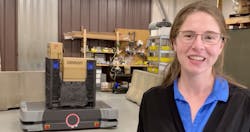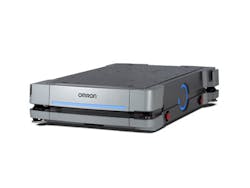At PACK EXPO Connects, Kate Cramer, automation engineer at Omron Automation, highlighted Omron’s newly released HD-1500—an autonomous, intelligent mobile robot that can handle payloads of up to 1500kg.
In her presentation, Cramer explained the difference between autonomous mobile robots (AMRs) and autonomous guided vehicles (AGVs). Cameras used with AMRs enable them to navigate a facility without the need for facility modification (such as floor guides or tracks). She said that AMRs can also safely avoid obstacles without stopping through their use of cameras and sensors. When traditional AGVs encounter obstacles, they may stop or stall until the obstacle has been removed.
“The HD-1500 is specifically designed for industrial environments and allows for the movement of large payloads while reducing the need for forklifts,” Cramer said. “Typical applications include high-payload transporting of materials or finished products such as wrapped pallets, modular equipment, and subassemblies to and from the warehouse or from one location to the next.”
Using Omron’s Fleet Manager software, the HD-1500 can calculate the best route for material transport while navigating safely around people and obstacles. Omron’s Fleet Manager can control up to 100 mobile robots of different sizes, configurations, and payload capacities, such as Omron’s other mobile robots—the LD-60/90 and LD-250.
The HD-1500 features safety-rated front lasers, safety-rated rear lasers, a front low laser and a rear low laser to provide 360 degrees of safety coverage and allow for precise pick-up and drop-off of materials. Two optional side lasers give the unit “vertical awareness to avoid overhanging obstacles. These side lasers also create two light curtains for anti-collision detection,” said Cramer.
The robot can operate for up to nine hours loaded or 12.5 hours unloaded and can be fully charged in less than 40 minutes.



